A Kernel-Based Calibration Algorithm for Chromatic Confocal Line Sensors
Abstract
1. Introduction
2. Methods
2.1. Coordinate Systems
2.2. Transformation in Z Direction
2.3. Transformation in X Direction
3. Results
3.1. Groove Fitting
3.2. Depths at Different Heights
3.3. Depths Measurements
4. Conclusions
Author Contributions
Funding
Institutional Review Board Statement
Informed Consent Statement
Data Availability Statement
Conflicts of Interest
References
- Minsky, M. Microscopy Apparatus. United States Patent Office. U.S. Patent 3,013,467, 19 December 1961. [Google Scholar]
- Sheppard, C.; Choudhury, A. Image formation in the scanning microscope. Opt. Acta Int. J. Opt. 1977, 24, 1051–1073. [Google Scholar] [CrossRef]
- Wilson, T.; Sheppard, C. Theory and Practice of Scanning Optical Microscopy; Academic Press: London, UK, 1984; Volume 180. [Google Scholar]
- Davidovits, P.; Egger, M.D. Scanning laser microscope. Nature 1969, 223, 831. [Google Scholar] [CrossRef] [PubMed]
- Cox, I.J. Super resolution by confocal fluorescent microscopy. Optik 1982, 60, 391–396. [Google Scholar]
- Tiziani, H.J.; Uhde, H.M. Three-dimensional image sensing by chromatic confocal microscopy. Appl. Opt. 1994, 33, 1838–1843. [Google Scholar] [CrossRef] [PubMed]
- Ruprecht, A.K.; Koerner, K.; Wiesendanger, T.F.; Tiziani, H.J.; Osten, W. Chromatic confocal detection for high-speed microtopography measurements. In Proceedings of the Three-Dimensional Image Capture and Applications VI International Society for Optics and Photonics, Cohin, India, 8–11 December 2004; Volume 5302, pp. 53–60. [Google Scholar]
- Seppä, J.; Niemelä, K.; Lassila, A. Metrological characterization methods for confocal chromatic line sensors and optical topography sensors. Meas. Sci. Technol. 2018, 29, 054008. [Google Scholar] [CrossRef]
- Hu, H.; Mei, S.; Fan, L.; Wang, H. A line-scanning chromatic confocal sensor for three-dimensional profile measurement on highly reflective materials. Rev. Sci. Instrum. 2021, 92, 053707. [Google Scholar] [CrossRef] [PubMed]
- Molesini, G.; Pedrini, G.; Poggi, P.; Quercioli, F. Focus-wavelength encoded optical profilometer. Opt. Commun. 1984, 49, 229–233. [Google Scholar] [CrossRef]
- Browne, M.; Akinyemi, O.; Boyde, A. Confocal surface profiling utilizing chromatic aberration. Scanning 1992, 14, 145–153. [Google Scholar] [CrossRef]
- Lin, P.C.; Sun, P.C.; Zhu, L.; Fainman, Y. Single-shot depth-section imaging through chromatic slit-scan confocal microscopy. Appl. Opt. 1998, 37, 6764–6770. [Google Scholar] [CrossRef] [PubMed]
- Shi, K.; Li, P.; Yin, S.; Liu, Z. Chromatic confocal microscopy using supercontinuum light. Opt. Express 2004, 12, 2096–2101. [Google Scholar] [CrossRef] [PubMed]
- Luo, D.; Kuang, C.; Liu, X. Fiber-based chromatic confocal microscope with Gaussian fitting method. Opt. Laser Technol. 2012, 44, 788–793. [Google Scholar] [CrossRef]
- Yanlei, L.; Qingzeng, M.; Leiguang, N.; Wei, C. Research of chromatic spectral peak location on confocal point sensors. J. Phys. Conf. Ser. 2020, 1678, 012092. [Google Scholar] [CrossRef]
- Chen, C.; Wang, J.; Liu, X.; Lu, W.; Zhu, H.; Jiang, X.J. Influence of sample surface height for evaluation of peak extraction algorithms in confocal microscopy. Appl. Opt. 2018, 57, 6516–6526. [Google Scholar] [CrossRef] [PubMed]
- Chen, C.; Wang, J.; Zhang, C.; Lu, W.; Liu, X.; Lei, Z.; Yang, W.; Jiang, X.J. Influence of optical aberrations on the peak extraction in confocal microscopy. Opt. Commun. 2019, 449, 24–32. [Google Scholar] [CrossRef]
- Lu, W.; Chen, C.; Zhu, H.; Wang, J.; Leach, R.; Liu, X.; Wang, J.; Jiang, X. Fast and accurate mean-shift vector based wavelength extraction for chromatic confocal microscopy. Meas. Sci. Technol. 2019, 30, 115104. [Google Scholar] [CrossRef]
- Liu, L.; Ma, H.; Shi, Z.; Bai, J. A Real-Time Peak Extraction Algorithm for Dynamic Displacement Measurement Based on Spectral Confocal Microscopy. J. Phys. Conf. Ser. 2021, 2112, 012015. [Google Scholar] [CrossRef]
- Garzón R, J.; Meneses, J.; Tribillon, G.; Gharbi, T.; Plata, A. Chromatic confocal microscopy by means of continuum light generated through a standard single-mode fibre. J. Opt. Pure Appl. Opt. 2004, 6, 544. [Google Scholar]
- Berkovic, G.; Zilberman, S.; Shafir, E. Temperature effects in chromatic confocal distance sensors. In Proceedings of the SENSORS, Baltimore, MD, USA, 3–6 November 2013; IEEE: Piscataway, NJ, USA, 2013; pp. 1–3. [Google Scholar]
- Yu, Q.; Zhang, K.; Zhou, R.; Cui, C.; Cheng, F.; Fu, S.; Ye, R. Calibration of a chromatic confocal microscope for measuring a colored specimen. IEEE Photonics J. 2018, 10, 1–9. [Google Scholar] [CrossRef]
- Qin, M.; Xiong, X.; Xie, H.; Xiao, E. Optical Lens, Optical System and Spectrum Confocal Sensor. CN Patent CN216772095U, 17 June 2022. [Google Scholar]
- Bai, J.; Li, X.; Wang, X.; Zhou, Q.; Ni, K. Chromatic confocal displacement sensor with optimized dispersion probe and modified centroid peak extraction algorithm. Sensors 2019, 19, 3592. [Google Scholar] [CrossRef] [PubMed]
- Qin, M.; Xiong, X.; Xie, H.; Xiao, E. Peak Value ExtractionMethod, Peak VALUE DetectionMethod and Peak Value Detection System of Spectrum Confocal Displacement Sensor. CN Patent 114370820, 1 July 2022. [Google Scholar]
- Rui, Y.; Yu, Y.; Bin, X.; Ansu, W.; Ziwei, L.; Chenxing, L. Design of dispersive objective lens of large linear chromatic confocal 3D surface profiler. High Power Laser Part. Beams 2018, 30, 051002. [Google Scholar]

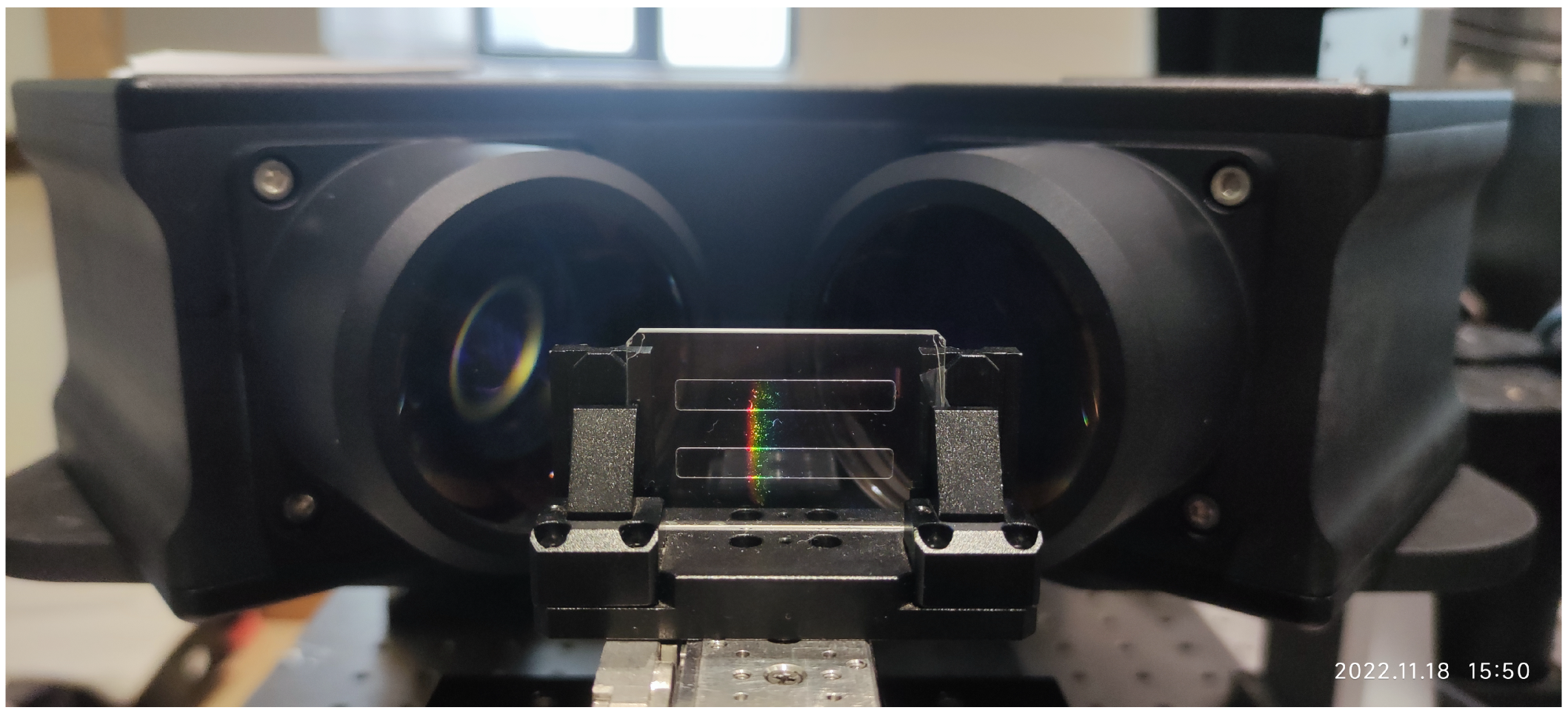
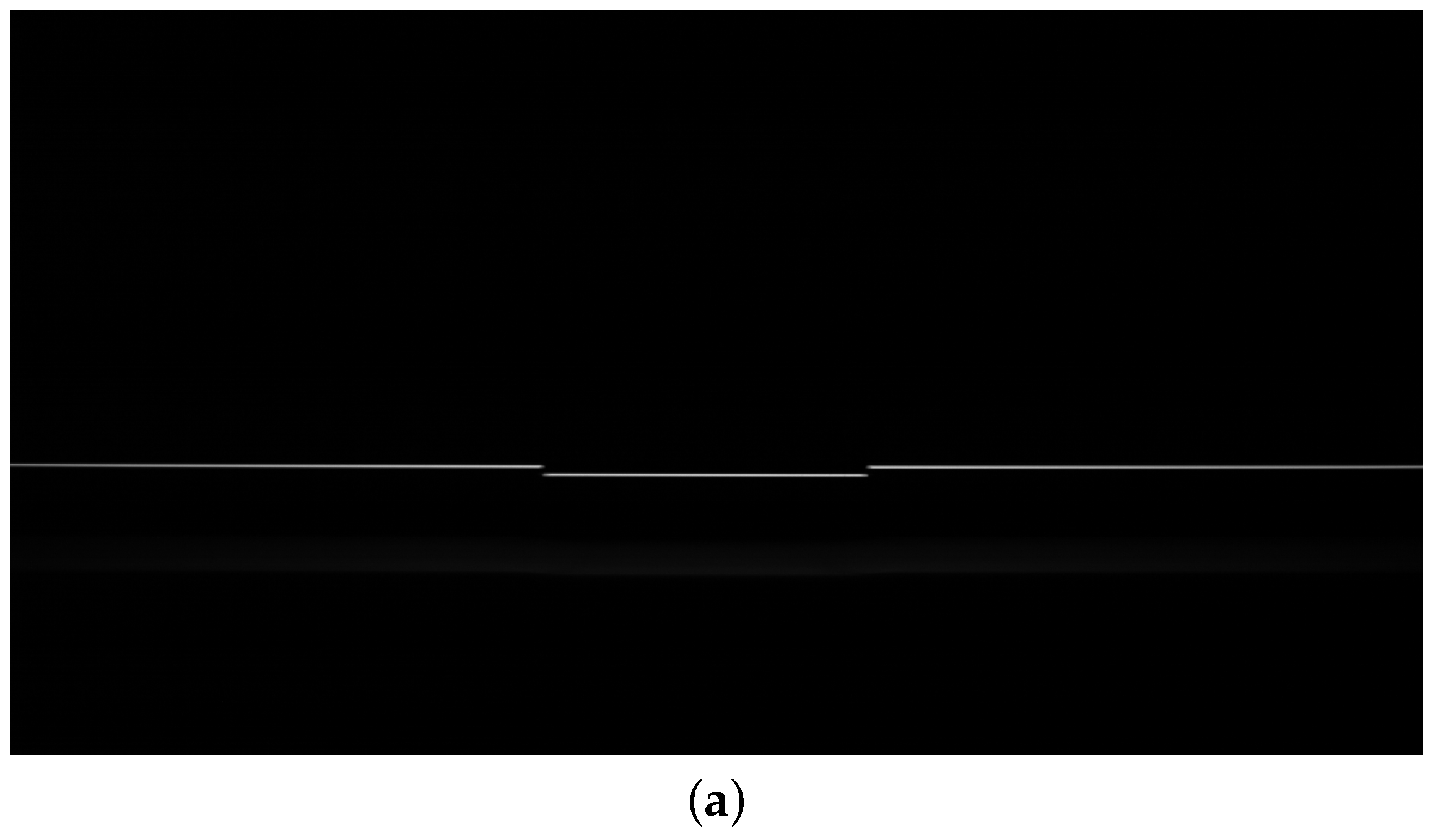
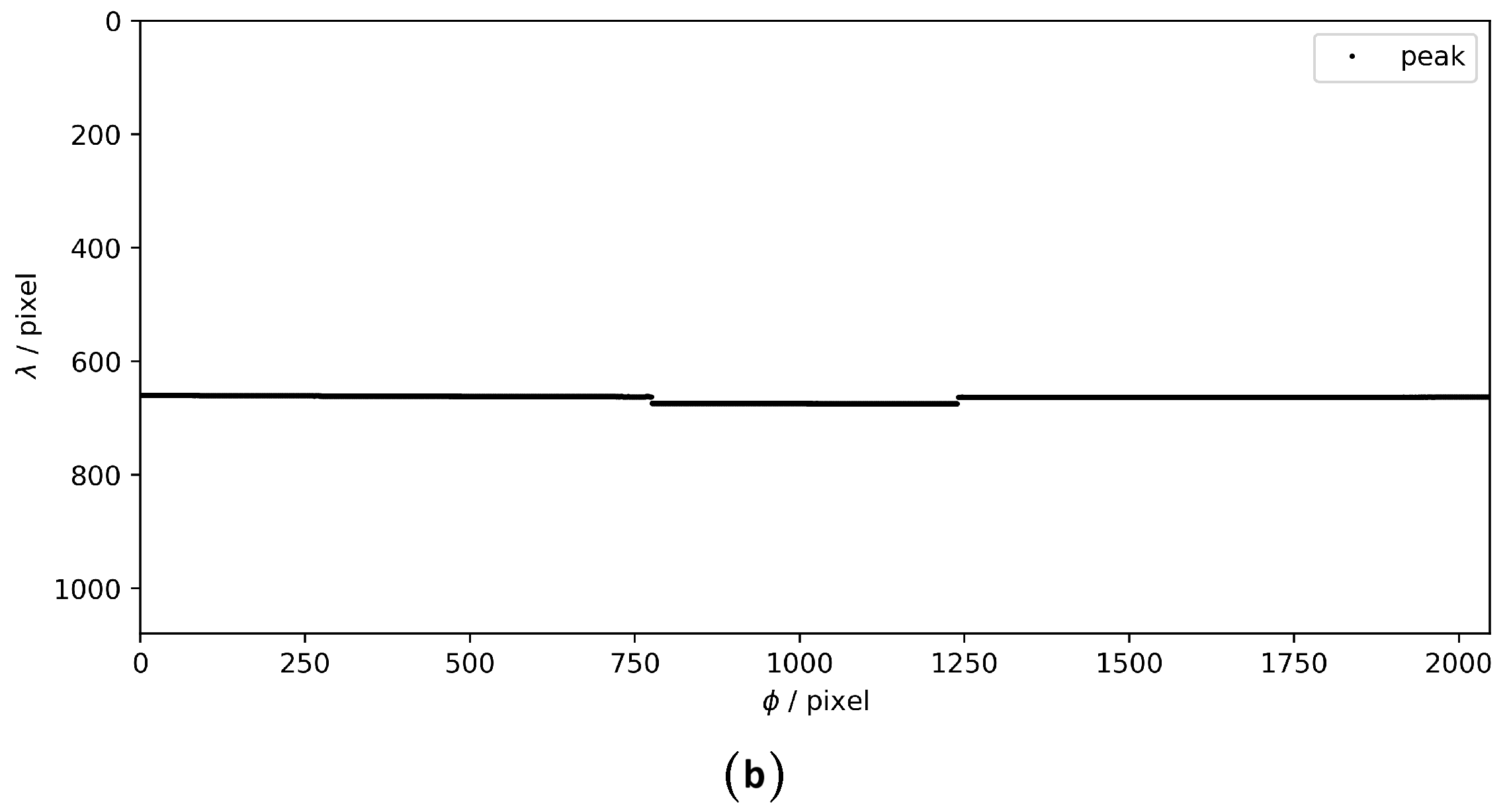
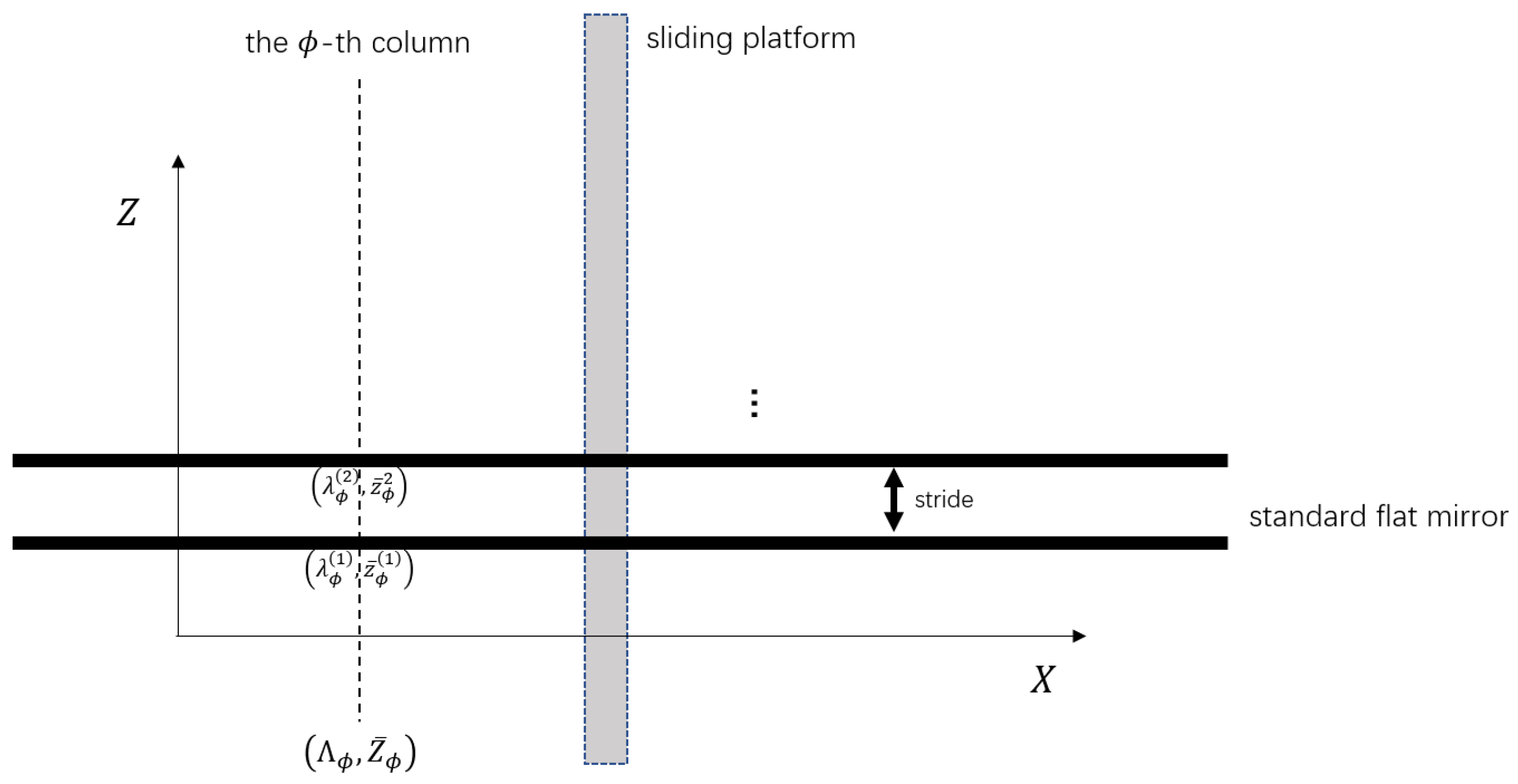

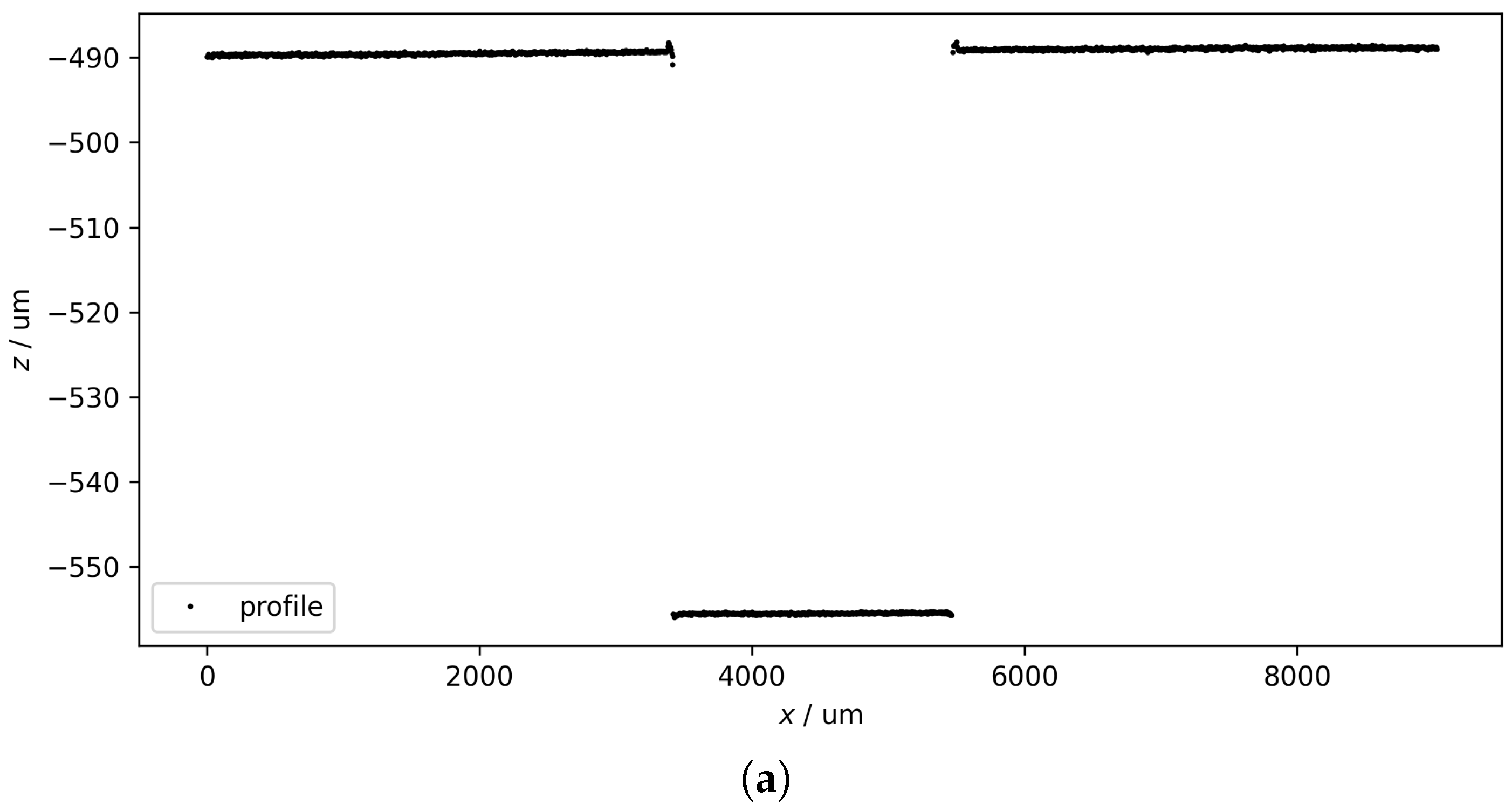
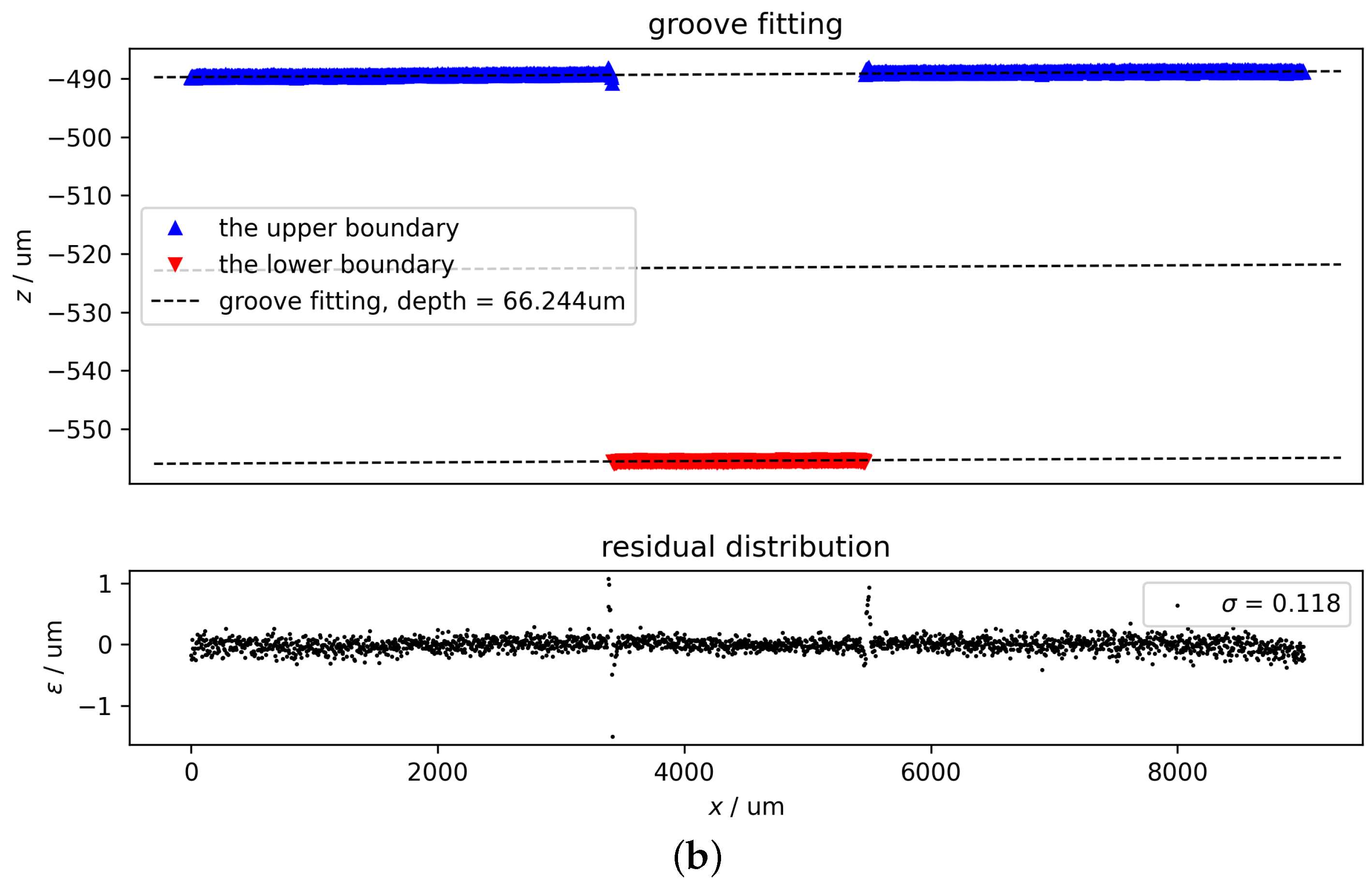
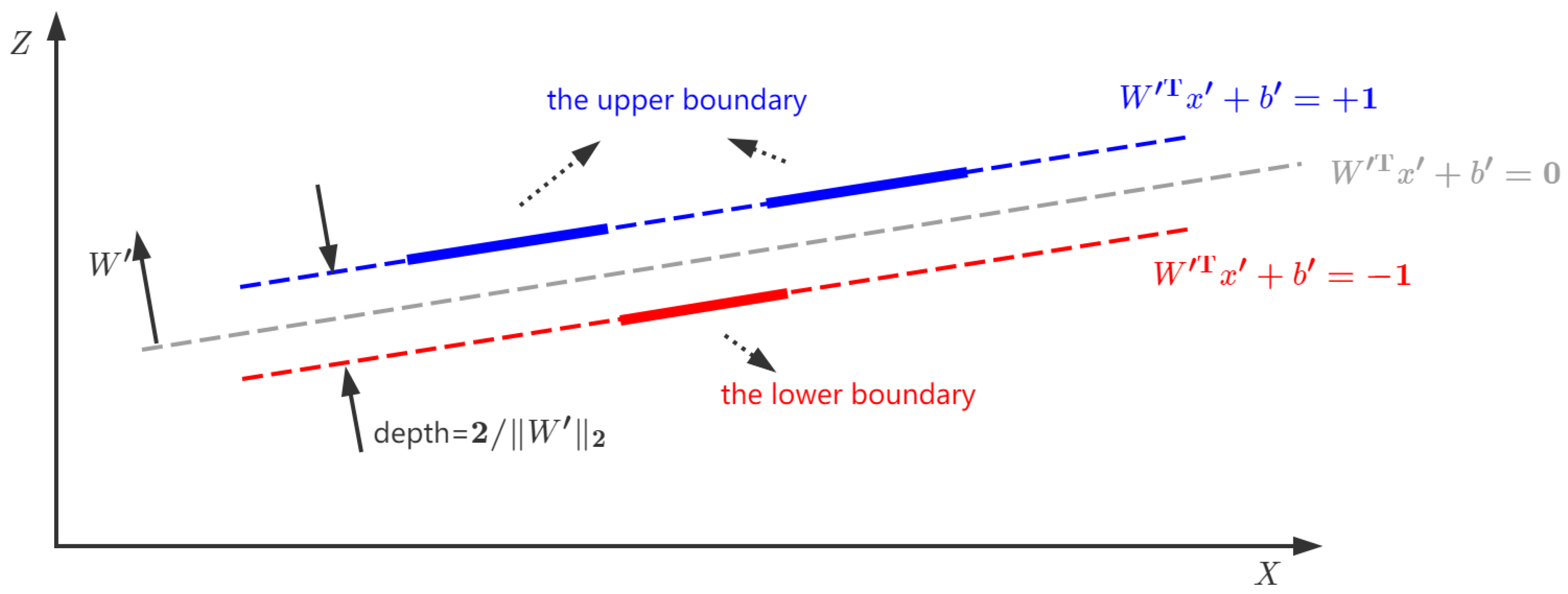
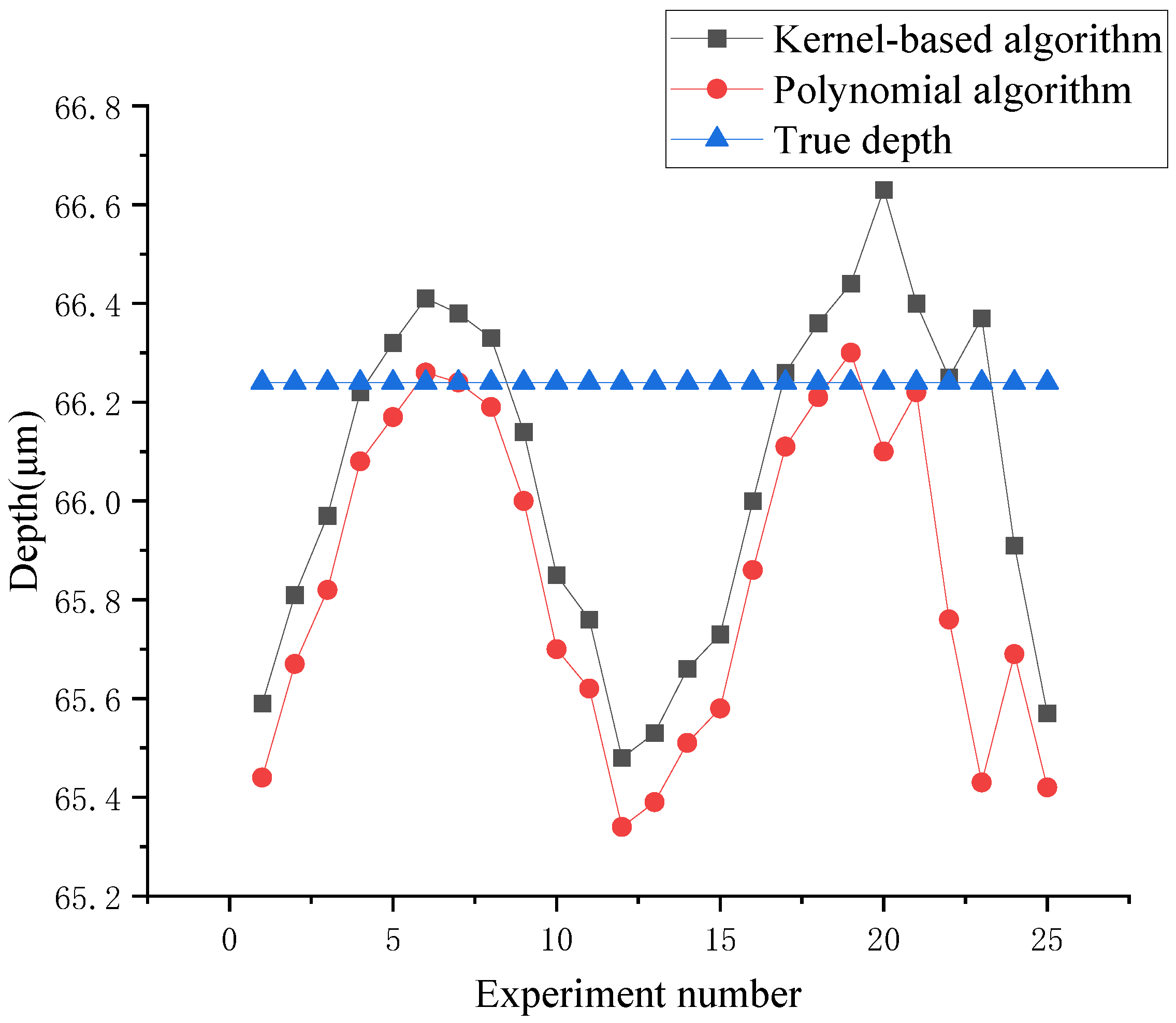
| True Depth | Polynomial Algorithm | Kernel-Based Algorithm | |||
|---|---|---|---|---|---|
| Depth | Error | Depth | Error | ||
| 1 | 66.14 | 65.44 | −0.70 | 65.59 | −0.55 |
| 2 | 65.67 | −0.47 | 65.81 | −0.33 | |
| 3 | 65.82 | −0.32 | 65.97 | −0.17 | |
| 4 | 66.08 | −0.06 | 66.22 | 0.08 | |
| 5 | 66.17 | 0.03 | 66.32 | 0.18 | |
| 6 | 66.26 | 0.12 | 66.41 | 0.27 | |
| 7 | 66.24 | 0.10 | 66.38 | 0.24 | |
| 8 | 66.19 | 0.05 | 66.33 | 0.19 | |
| 9 | 66.00 | −0.14 | 66.14 | 0.00 | |
| 10 | 65.70 | −0.44 | 65.85 | −0.29 | |
| 11 | 65.62 | −0.52 | 65.76 | −0.38 | |
| 12 | 65.34 | −0.80 | 65.48 | −0.66 | |
| 13 | 65.39 | −0.75 | 65.53 | −0.61 | |
| 14 | 65.51 | −0.63 | 65.66 | −0.48 | |
| 15 | 65.58 | −0.56 | 65.73 | −0.41 | |
| 16 | 65.86 | −0.28 | 66.00 | −0.14 | |
| 17 | 66.11 | −0.03 | 66.26 | 0.12 | |
| 18 | 66.21 | 0.07 | 66.36 | 0.22 | |
| 19 | 66.30 | 0.16 | 66.44 | 0.30 | |
| 20 | 66.10 | −0.04 | 66.63 | 0.49 | |
| 21 | 65.22 | 0.08 | 66.40 | 0.26 | |
| 22 | 65.76 | −0.38 | 66.25 | 0.11 | |
| 23 | 65.43 | −0.71 | 66.37 | 0.23 | |
| 24 | 65.69 | −0.45 | 65.91 | −0.23 | |
| 25 | 65.42 | −0.72 | 65.57 | −0.57 | |
| Average error | −0.29 | −0.09 | |||
| Standard deviation | 0.50 | 0.38 | |||
Disclaimer/Publisher’s Note: The statements, opinions and data contained in all publications are solely those of the individual author(s) and contributor(s) and not of MDPI and/or the editor(s). MDPI and/or the editor(s) disclaim responsibility for any injury to people or property resulting from any ideas, methods, instructions or products referred to in the content. |
© 2024 by the authors. Licensee MDPI, Basel, Switzerland. This article is an open access article distributed under the terms and conditions of the Creative Commons Attribution (CC BY) license (https://creativecommons.org/licenses/by/4.0/).
Share and Cite
Qin, M.; Xiong, X.; Xiao, E.; Xia, M.; Gao, Y.; Xie, H.; Luo, H.; Zhao, W. A Kernel-Based Calibration Algorithm for Chromatic Confocal Line Sensors. Sensors 2024, 24, 6649. https://doi.org/10.3390/s24206649
Qin M, Xiong X, Xiao E, Xia M, Gao Y, Xie H, Luo H, Zhao W. A Kernel-Based Calibration Algorithm for Chromatic Confocal Line Sensors. Sensors. 2024; 24(20):6649. https://doi.org/10.3390/s24206649
Chicago/Turabian StyleQin, Ming, Xiao Xiong, Enqiao Xiao, Min Xia, Yimeng Gao, Hucheng Xie, Hui Luo, and Wenhao Zhao. 2024. "A Kernel-Based Calibration Algorithm for Chromatic Confocal Line Sensors" Sensors 24, no. 20: 6649. https://doi.org/10.3390/s24206649
APA StyleQin, M., Xiong, X., Xiao, E., Xia, M., Gao, Y., Xie, H., Luo, H., & Zhao, W. (2024). A Kernel-Based Calibration Algorithm for Chromatic Confocal Line Sensors. Sensors, 24(20), 6649. https://doi.org/10.3390/s24206649






